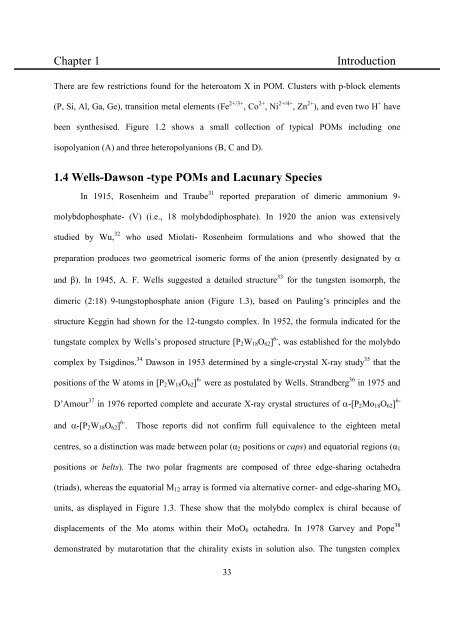Chapter 4 - Jacobs University
Chapter 4 - Jacobs University
Chapter 4 - Jacobs University
Create successful ePaper yourself
Turn your PDF publications into a flip-book with our unique Google optimized e-Paper software.
<strong>Chapter</strong> 1<br />
Introduction<br />
There are few restrictions found for the heteroatom X in POM. Clusters with p-block elements<br />
(P, Si, Al, Ga, Ge), transition metal elements (Fe 2+/3+ , Co 2+ , Ni 2+/4+ , Zn 2+ ), and even two H + have<br />
been synthesised. Figure 1.2 shows a small collection of typical POMs including one<br />
isopolyanion (A) and three heteropolyanions (B, C and D).<br />
1.4 Wells-Dawson -type POMs and Lacunary Species<br />
In 1915, Rosenheim and Traube 31 reported preparation of dimeric ammonium 9-<br />
molybdophosphate- (V) (i.e., 18 molybdodiphosphate). In 1920 the anion was extensively<br />
studied by Wu, 32<br />
who used Miolati- Rosenheim formulations and who showed that the<br />
preparation produces two geometrical isomeric forms of the anion (presently designated by a<br />
and b). In 1945, A. F. Wells suggested a detailed structure 33 for the tungsten isomorph, the<br />
dimeric (2:18) 9-tungstophosphate anion (Figure 1.3), based on Pauling’s principles and the<br />
structure Keggin had shown for the 12-tungsto complex. In 1952, the formula indicated for the<br />
tungstate complex by Wells’s proposed structure [P 2 W 18 O 62 ] 6- , was established for the molybdo<br />
complex by Tsigdinos. 34 Dawson in 1953 determined by a single-crystal X-ray study 35 that the<br />
positions of the W atoms in [P 2 W 18 O 62 ] 6- were as postulated by Wells. Strandberg 36 in 1975 and<br />
D’Amour 37 in 1976 reported complete and accurate X-ray crystal structures of a-[P 2 Mo 18 O 62 ] 6-<br />
and a-[P 2 W 18 O 62 ] 6- . Those reports did not confirm full equivalence to the eighteen metal<br />
centres, so a distinction was made between polar (α 2 positions or caps) and equatorial regions (α 1<br />
positions or belts). The two polar fragments are composed of three edge-sharing octahedra<br />
(triads), whereas the equatorial M 12 array is formed via alternative corner- and edge-sharing MO 6<br />
units, as displayed in Figure 1.3. These show that the molybdo complex is chiral because of<br />
displacements of the Mo atoms within their MoO 6 octahedra. In 1978 Garvey and Pope 38<br />
demonstrated by mutarotation that the chirality exists in solution also. The tungsten complex<br />
33

















